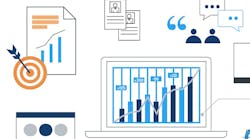Expect More Tariff-Driven Price Hikes Across Manufacturing: Distributor CEOs
Key Highlights
- Many industrial firms have been raising prices in response to tariffs, with some experiencing surges of supplier cost pass-throughs unexpectedly.
- Some firms initially stockpiled inventory to mitigate tariff effects but are now facing the need to pass costs onto customers as margins shrink.
- Tariff impacts are expected to persist into 2026, delaying the return to pre-tariff profitability and requiring ongoing cost management strategies.
Feeling a bit ambushed by price increases of late? You’re not alone—and it’s likely not over.
Speaking to analysts and investors recently, several industrial companies—including two prominent distributors of metalworking and maintenance, repair and operations gear—said they have been hiking prices in recent months because of tariff pressures coming their way from suppliers. And they are pushing through more increases, albeit on a smaller scale, as we prepare for 2026.
The Oct. 23 earnings conference call from MSC Industrial Direct Co Inc. provided a poignant anecdote: President and COO Martina McIsaac told analysts that the distributor’s leaders were caught off guard this summer—shortly after they had raised their own prices—by a surge of suppliers passing on tariff-related costs.
“Between mid-June […] and the end of August, in those weeks, we took more inflation than we took in nine months post-COVID in 2022. So that kind of gives you a feeling for scale,” McIsaac said. “It was both the number of increases, the changes in the increases, the changes in supplier behavior, compressed lead times.”
McIsaac said the MSC team has in recent weeks begun pushing through another price increase of its own. But there may be more work to do in coming months. CEO Erik Gershwind said the company’s suppliers are talking about ongoing cost pressures on some of their raw materials “that are heavily China-based or -influenced.”
“And if this sustains, it could lead to further price inflation in the coming months,” Gerschwind said.
MSC’s peers at W.W. Grainger Inc. delivered a similar message to investors on the morning of Halloween: After launching prices increases on some products in May and more broadly in September (a normal price cycle increase for the company), the team led by Chairman and CEO D.G. Macpherson and CFO Dee Merriwether have been pushed to launch another round of hikes this month, in part due to the Trump administration’s newer Section 232 tariffs.
And, as with MSC’s avalanche of activity from suppliers, Grainger has faced unusual circumstances.
“There’s been over 1,000 negotiations with our suppliers at this point,” Macpherson said. “That’s not normal, for the record.”
Merriwether told analysts and investors the latest price increases are “only modest in nature” and seek to merely make good suppliers’ hikes. But they’re unlikely to be the last in a while.
“Based upon what we’re hearing from suppliers as part of our annual cost cycle, we expect further inflationary pressure into 2026.”
The recovery timeline gets extended
Raising prices has been an expected and widespread reaction to the tariff bonanza President Trump rolled out earlier this year. An August survey by Endeavor Business Intelligence, the research division of IndustryWeek parent company EndeavorB2B, showed that more than half of respondents had hiked prices to offset at least some tariff-related costs.
That meant half hadn’t yet by mid-summer. Economists have speculated that some leadership teams decided they just couldn’t raise prices for fear of losing customers while others have chosen to at least temporarily sacrifice some of their margin. Also a factor: Some companies pulled forward some spending on supplies early in the year to mitigate possible tariff impacts—but they are now running low or out of those lower-cost inputs.
There’s been over 1,000 negotiations with our suppliers at this point. That’s not normal, for the record.
- W.W. Grainger Chairman and CEO D.G. Macpherson
“Everyone’s gut feel is starting to bear out in the data. Yep, we had a good stockpile of inventory. We held onto that. We waited to see what was happening,” Dan Cankora, a pricing economist and business consultant at Vendavo, said during a recent IndustryWeek webinar previewing 2026 in manufacturing. “But now the reality is, if our margins are getting crushed due to higher costs, we’re going to push that through on price. We’re starting to see the beginning of that.”
The grinding nature of the administration’s tariffs—and tariffs stacked on top of tariffs—showed up in the third-quarter earnings presentation of Regal Rexnord Corp., which makes switchgear, power distribution equipment and HVAC parts. CEO Louis Pinkham and his team updated investors as to the expected cost impact of tariffs. After March’s estimate of $60 million and May’s $130 million ballpark figure, the 2025 impact is now expected to total $175 million.
CFO Rob Rehard said the Regal Rexnord team is working to offset that weight by relocating some production, cutting some costs, changing some suppliers and, yes, pushing through some prices hikes.
“Our associates continue to overmanage the impacts,” Rehard told analysts on Oct. 30.
Chances are a large number of companies—likely the vast majority of them—do just that and rely at least partly on price, a resolution to the grinding inflationary cycle that seems to have started this summer will be pushed further out. And it will come at some cost: Pinkham and Rehard in August said they expected Regal Rexnord’s adjusted EBITDA to get back to its pre-tariff level by year’s end. Three months later, they think it will take until mid-2026.
About the Author
Geert De Lombaerde
Senior Editor
A native of Belgium, Geert De Lombaerde has been in business journalism since the mid-1990s and writes about public companies, markets and economic trends for Endeavor Business Media publications, focusing on IndustryWeek, FleetOwner, Oil & Gas Journal, T&D World and Healthcare Innovation. He also curates the twice-monthly Market Moves Strategy newsletter that showcases Endeavor stories on strategy, leadership and investment and contributes to other Market Moves newsletters.
With a degree in journalism from the University of Missouri, he began his reporting career at the Business Courier in Cincinnati in 1997, initially covering retail and the courts before shifting to banking, insurance and investing. He later was managing editor and editor of the Nashville Business Journal before being named editor of the Nashville Post in early 2008. He led a team that helped grow the Post's online traffic more than fivefold before joining Endeavor in September 2021.


